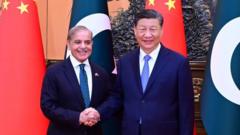In the aftermath of the recent conflict between India and Pakistan, both countries claimed victory while discussions about the potential benefits for China's defense industry emerged. As Pakistan deployed Chinese-made aircraft in combat, experts analyze how these developments might influence regional security dynamics and global arms trade.
Has China's Defense Industry Emerged Victorious Amidst the India-Pakistan Clash?

Has China's Defense Industry Emerged Victorious Amidst the India-Pakistan Clash?
The recent India-Pakistan conflict raises questions about the implications for China's defense sector, following the combat debut of Chinese-made warplanes used by Pakistan.
The four-day conflict between India and Pakistan, which ignited on May 7th, concluded with a ceasefire, leaving both nations asserting they emerged victorious. However, the conflict has also led to growing questions about the unanticipated advantages it may have provided to China's defense industry. The clash began in response to a brutal attack that killed 26 people, leading India to conduct what it termed "Operation Sindoor," targeting alleged "terrorist infrastructure" within Pakistan. This led to a series of military retaliations, as both nations utilized various combat aircraft in their operations.
India's aerial assaults reportedly involved a combination of French and Russian-built jets, while Pakistan's responses prominently featured its J-10 and J-17 fighter jets, co-produced with China. Both countries asserted their military assets remained within their airspace, engaged in missile exchanges from a distance. Pakistan alleged it had downed multiple Indian planes, including modern French fighter jets, although New Delhi has not confirmed these claimed losses.
The performance of Chinese-made aircraft, particularly, has been highlighted as a key factor in this conflict. Analysts argue that Pakistan's use of these jets during active combat may positively influence perceptions about the reliability and efficacy of Chinese military technology. Zhou Bo, a former senior colonel in China's military, noted that this situation served as an advertisement for Chinese military systems, allowing them to be field-tested for the first time.
Market reactions have supported this perspective, as shares in the Chinese manufacturer of the J-10 aircraft surged considerably following reports of its performance during the conflict. However, other defense analysts caution against premature conclusions, emphasizing that a full assessment of the outcomes is still pending. For instance, Professor Walter Ladwig from King's College raised questions about the operational context and strategy employed by both air forces, suggesting that it remains unclear whether the Chinese jets were ultimately superior.
As reports of the conflict circulate, a wave of nationalistic fervor has emerged on Chinese social media, celebrating the supposed success of Chinese assets. This sentiment may influence China's broader relationship with Pakistan, as Beijing has invested heavily in the nation for regional stability through the China-Pakistan Economic Corridor, worth over $50 billion.
Experts forecast that the conflict's implications might extend beyond the immediate region, as military experts from around the world analyze the effectiveness of Chinese aircraft in a real combat scenario, potentially reshaping the global arms market dynamics. In contrast, some analysts point out that India demonstrated an ability to strike a wide array of targets across Pakistan, even as its military narrative faced challenges regarding transparency and communication.
As the dust settles and international observers reflect on these developments, the India-Pakistan conflict serves as a critical juncture for understanding China's growing military influence, as well as the security considerations facing both regional powers. In light of its responses and capabilities, India may be compelled to accelerate its defense modernization efforts, knowing that its adversaries' military capabilities are quickly evolving, driven in part by Chinese advancements.




















